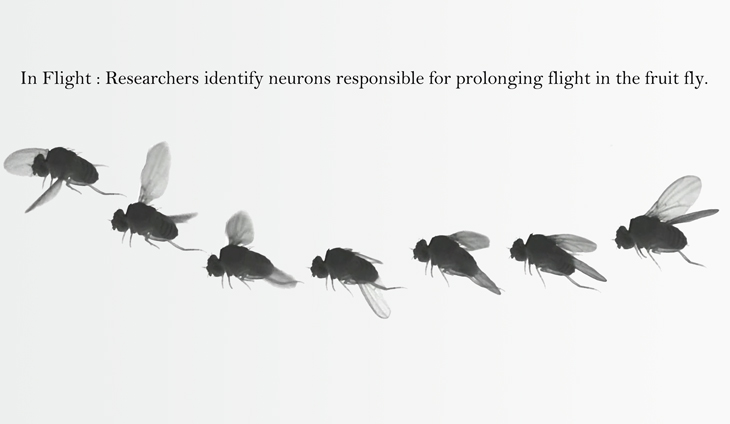In Flight: Researchers identify neurons responsible for prolonging flight in the fruit fly.
Scientists at the National Centre for Biological Sciences (NCBS) have gained new insights into the flying mechanisms of the fruit fly by studying the inner workings of this organism. Drosophila melanogaster, commonly known as the fruit fly, is a model organism in bioscience research because of its short life span and amenability to genetic manipulation.
Through this study, researchers Gaiti Hasan and Tarjani Agrawal aimed to discover neuronal pathways responsible for maintaining flight in fruit flies. "We started by asking what exact pathways within the neurons have a visible effect on Drosophila flight," explains Tarjani Agrawal, a Research Scholar at the lab and first author of this paper.
Basic science questions such as these are difficult to study in larger organisms such as birds, but the fruit fly has historically provided researchers with an alternative medium for conducting such studies. Over the past few years, studies on the fruit fly's mating behaviour, flight patterns and genetic link to human beings have been common. But this recent study has successfully linked specific neuronal activity within the fruit fly's brain to its ability to fly for prolonged periods of several minutes.
Findings of this paper also include a new pathway by which calcium is released within a neuron. Usually, G-protein couple receptors (GPCRs) are present on the plasma cell surface and respond to a variety of external signals. These external signals, known as ligands, may come in the form of neurotransmitters, peptides, lipids, sugars, proteins and so on. GPCRs are linked to a G-protein, and when a ligand binds with a GPCR, it activates the G-protein.
Activation of the G-protein results in the production of multiple second messenger molecules whose function is to relay the signal from the plasma membrane to specific molecules within the cytosol of the cell. One such molecule is the inositol 1, 4, 5-triphosphate(IP3). Within the cell, the IP3 molecule is received by the IP3-gated calcium channel which is present on the Endoplasmic Reticulum (ER) of the cell. When IP3 binds to this receptor, there is a release of calcium ions (Ca2+) within the cytosol of the cell.
"We already knew that the IP3 receptors responsible for calcium signaling are required to regulate flight in Drosophila," said Ms. Agrawal, "but we also discovered something else."
Frizzled2 (Fz2), a specific GPCR, was identified by the researchers while screening for GPCRs required for flight in the fruit fly. Neurons that require Fz2 signaling to increase calcium levels in the cells were subsequently mapped. These neurons were responsible for maturation of the flight circuit in the fruit flies brain.
The Fz2 pathway has been extensively studied but has only occasionally been linked to the release of calcium within the cell. This paper is one of the few that successfully concludes that Fz2 mediates calcium signaling. Additionally, this paper shows evidence the Fz2 pathway is required for a physiological response - it affects the time for which the fly can continue flying.
"When we knockdown this signaling pathway in the neuron of the fly, we noticed that the flies couldn't fly for longer than 10 to 20 seconds,"explained Ms. Agrawal, "We have gone one step further and found that Frizzled2 mediated calcium signaling is required to maintain an optimum dopamine level in the neuron and dopamine is already known to be required for flight, according to an earlier publication from our lab." These studies were conducted through behavioral experiments by tethering the fruit fly and testing its flight. Besides this, several other quantitative tests were conducted to derive the results.
The neurons identified as responsible for flight in the fruit fly were the Protocerebral Anterior Medial (PAM) neurons, a cluster of 120 dopaminergic neurons, which are anatomically and functionally connected to a higher brain structure called the Mushroom Body (MB). Dopaminergic neurons such as the PAM neurons produce dopamine within the cell and release it. The Mushroom Body, which has earlier been associated with olfactory memory formation and locomotor activity in the fly, can now be conclusively linked to the flight of the fly.
This paper highlights several interesting findings in the field of neurobiology. The first is evidence of the Frizzled2 pathway in activation of calcium and the second is the connection between PAM neurons and the Mushroom Body in the context of flight. Having established this, future research within Dr. Hasan's lab has been directed to identifying which among the 120 PAM neurons are specifically required for flight.
Link to paper:
This paper was published in eLife on 8th May 2015.
http://elifesciences.org/content/early/2015/05/08/eLife.07046
Dr. Gaiti Hasan runs a neurobiology and molecular genetics lab at the National Centre for Biological Sciences (NCBS) within the Tata Institute of Fundamental Research. Tarjani Agrawal is PhD candidate and a Research Scholar at NCBS (https://www.ncbs.res.in/gaiti)
Interview with Tarjani Agrawal in eLife
http://elifesciences.org/elife-news/Connecting-the-flight-controls-an-in...
Farida Kothari is a writer with the Research Media Services Division of Gubbi Labs.

Comments
Post new comment